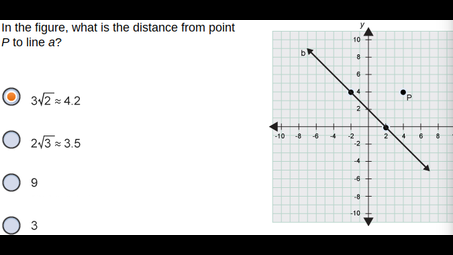What else can I help you with?
If Point p is on line m then how many plane are perpendicular to line m and also passes through point p?
1
What does area and perimeter mean?
P = the distance around a figure. A = the surface it takes up.
How do you negate the euclidean parallel postulate?
Assume there are no lines through a given point that is parallel to a given line or assume that there are many lines through a given point that are parallel to a given line. There exist a line l and a point P not on l such that either there is no line m parallel to l through P or there are two distinct lines m and n parallel to l through P.
How do you find the missing endpoint of a segment with an endpoint and a midpoint?
The direction of missing endpoint is the same as the direction from the known end point to the midpoint. The distance from the midpoint to the missing endpoint is the same as the distance from the known end point to the midpoint. In coordinate geometry it is simple. If the known end point is (p, q) and the mid point is (r, s) then the missing point is (2r - p, 2s - q).
Find PD if the coordinate of P is -7 and the coordinate of D is -1?
If p=(-7) and d=(-1) then the distance from p to d is determined by the distance formula for the one dimensional coordinate line:D=(x2-x1) d=x2, p=x1D=(-1)-(-7) = (-1)+7 = 6The positive number means the direction from p to d is from left to right on the coordinate line.
what- In the figure, what is the distance from point P to line a?
\sqrt(9.8)~ 3.13
what- in the figure, what is the distance from point P o line a?
3v/ 2 ~ 4.2
How do you find a p value when given the focus and directrix?
To find the p-value for a parabola given its focus and directrix, first identify the coordinates of the focus (F) and the equation of the directrix (a line). The p-value represents the distance from the vertex of the parabola to the focus (or the vertex to the directrix), which is half the distance between them. Calculate this distance using the formula for distance between a point and a line, or by measuring the distance from the vertex to either the focus or the directrix. The p-value is then the absolute value of this distance.
What is the first step in the construction of a line parallel to AB through point P?
The first step in constructing a line parallel to line AB through point P is to use a straightedge or ruler to draw a line from point P to line AB, ensuring that it intersects at some point. Next, using a compass, measure the angle between line AB and the line drawn from P, and then replicate that angle on the opposite side of point P to establish the direction of the parallel line. Finally, draw a line through point P in the direction of this angle, ensuring it remains parallel to line AB.
If Point p is on line m then how many plane are perpendicular to line m and also passes through point p?
1
What is the image of C for a 180 and deg Counter clockwise rotation about P?
To find the image of point C after a 180-degree counterclockwise rotation about point P, you first identify the coordinates of both points. Then, you reflect point C across point P, effectively moving it to the opposite side of P at an equal distance. The resulting image will be directly opposite C in relation to P, forming a straight line through P.
If a and b are two points in the plane the perpendicular bisector of Ab is the set of all points equidistant from a and b?
The perpendicular bisector of the line segment connecting points ( A ) and ( B ) in the plane is a line that divides the segment into two equal parts at a right angle. Every point on this line is equidistant from points ( A ) and ( B ). This means that if you take any point ( P ) on the perpendicular bisector, the distance from ( P ) to ( A ) will be the same as the distance from ( P ) to ( B ). Thus, the perpendicular bisector is the locus of points satisfying this equidistance condition.
Where is the shortest distance between any two points on the globe?
It depends on how complicated you want to make it. The generally accepted answer would be to start at one point, and make a line to the next (a straight line). That's gonna be the answer, say, your teacher might want (sorry if you're an adult :p). The technical answer? Drill a hole through the globe from one point to the other, and your shortest distance would be the straight line. Einstein's answer? A geodesic. Look it up :p
What is the reflection of point P-1 6 across the line y x?
To find the reflection of point P(-1, 6) across the line y = x, you swap the x and y coordinates of the point. Therefore, the reflection of P(-1, 6) is P'(6, -1).
What does area and perimeter mean?
P = the distance around a figure. A = the surface it takes up.
is this statement true or falseThe steps for constructing a line perpendicular to a given line through point P are the same whether P lies on the line or not.?
false
What is point slope form of an equation of a line?
Given a point P = (a,b) and slope m, the equation of a line through P with slope m is (y-b) = m(x-a)

